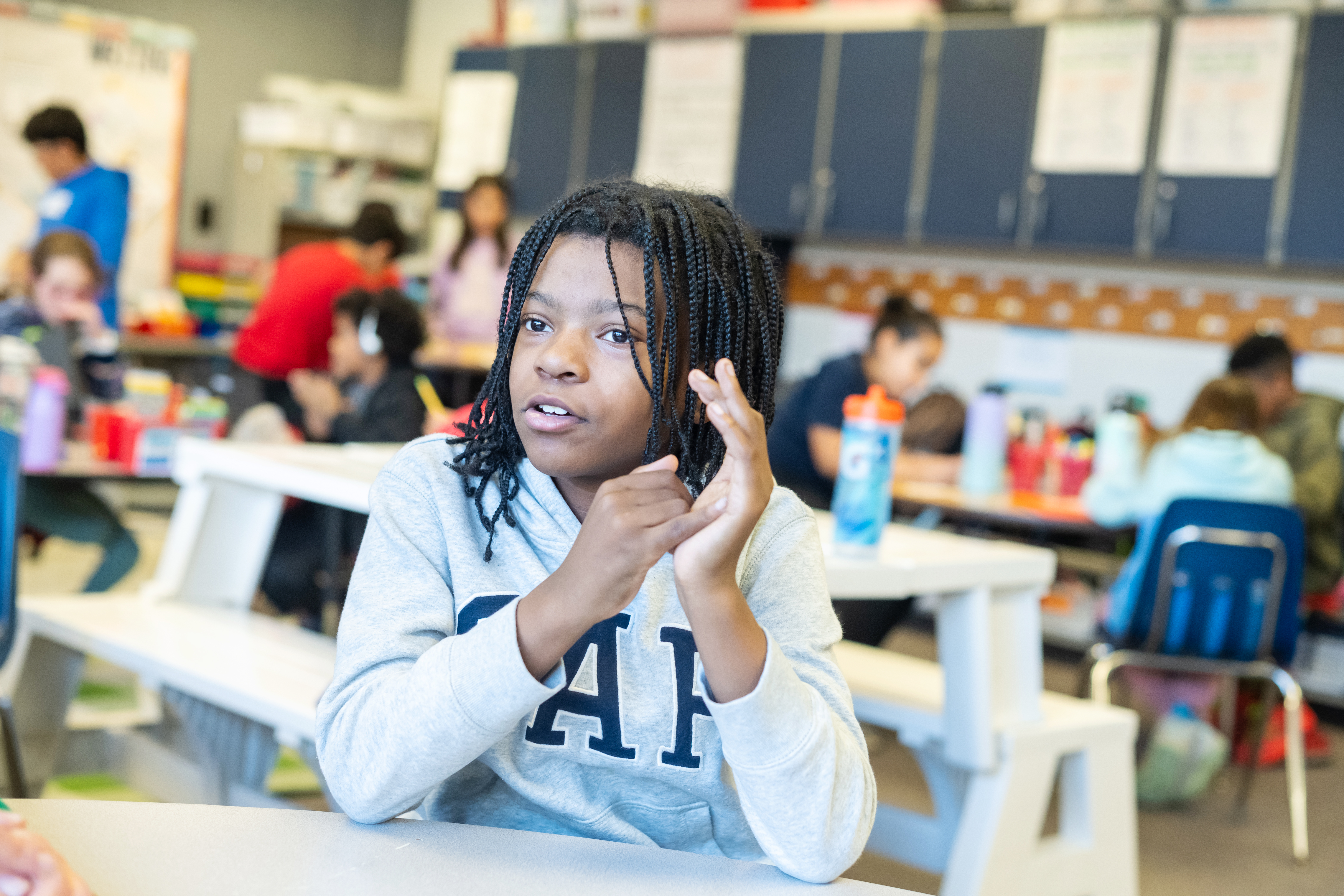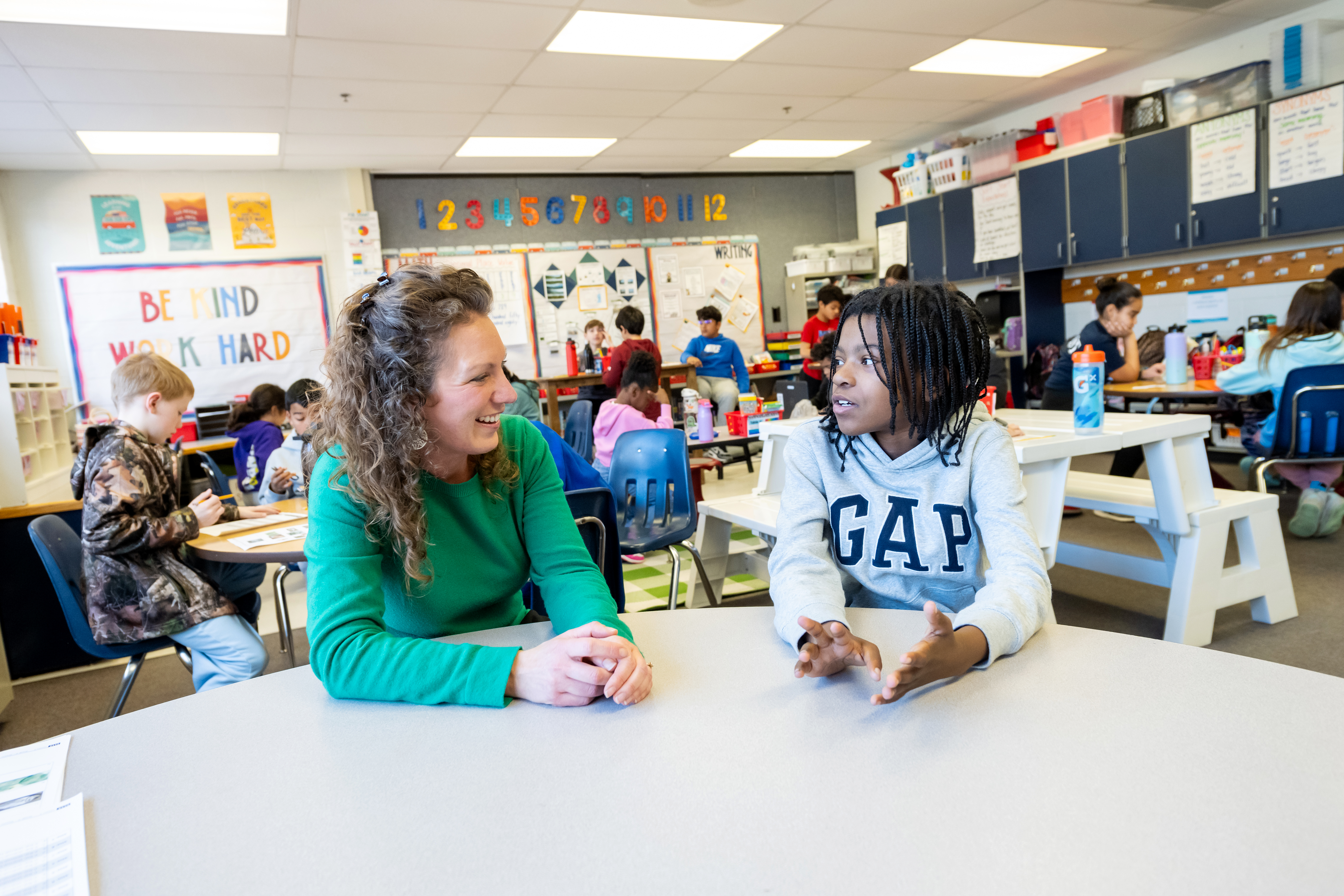“The Kids Just Light Up:” Hayfield Elementary Teachers Embrace Chat Challenge to Boost Students’ Sense of Belonging
Nina Long, a fourth grader at Hayfield Elementary School, was the new kid this year in Nicole Johnson’s classroom.
Even though Nina had gone to Hayfield for kindergarten, she’d spent the past three years at an elementary school in Maryland and was now back and reacclimating.
“When she first started this year, Nina was a little resistant to the community, a little reserved — seemed a bit like `I don’t know about this place or you people, ’” Johnson said. “She kind of kept people at arm’s length. And I saw that and I thought, we’re going to build a relationship here where every day we have a couple minute conversation and see where that takes us.”
So when Hayfield Elementary Principal Jessica Lewis announced a plan to increase a sense of belonging in their community by challenging staff to have short daily chats with students who had self-reported not feeling like they belonged, Johnson was immediately on board.
The new push directed teachers to review data from the biannual Social and Emotional Learning (SEL) Screener given to students in grades three through six. They looked for students in each class who rated themselves lower in terms of feeling part of a school community.
The Power of Personal Relationships
Then, the teachers were challenged to have daily two-minute chats — about anything EXCEPT school — with the students for 10 consecutive days. If a student or teacher was absent, the 10-day clock started over again.
Johnson had long believed in the power of building relationships with students. Each year she would periodically review class rosters and see if she could identify one positive trait about every student as well as one thing about their lives outside of school.
“If I get to a student where I pause, it becomes my goal for the day to work on finding something positive and something going on in the lives of students outside of school — if I can't do that, I also know that I am not spending enough time getting to know them as a person,” Johnson says.
She had already been doing the daily check-ins with Nina, the new student, before the principal’s plan began.

“I got to know SO much about her from the start. It didn’t take long to realize she is so incredibly bright, has her sights set on going to Princeton and then becoming a lawyer — all these things maybe I would have missed if we didn’t have these conversations early on,” Johnson said.
She’d learned Nina was an athlete, who loves basketball, plays nearly every chance she gets, and has a mother who makes a breakfast every day that has Nina eager to get out of bed.
Positive Changes
By late October, when Hayfield Elementary students were encouraged to attend Hayfield Secondary’s Homecoming football game, Johnson had already noticed a change in Nina.
“I walked in as a staff member going to help out with the event, and Nina was down right in front with a school banner — it was so neat to see because we could tell she already felt connected, there had already been that dramatic change just a couple months into the school year,” Johnson said.
Nina says at the start of the school year, she probably would have rated herself a 4 or 5 on a scale of 1 to 10 in terms of how much she felt she belonged to the Hayfield Elementary community. Now, she says, she’d give herself an 8 or 9.

“A bunch of people at the door greet me, they say, ‘Good morning Nina,’” she says, noting she’s been chatting with fifth and sixth grade teachers to get a sense of which classrooms she hopes to be in when she’s older.
In Johnson’s fourth grade classroom, the teacher says she tries to conduct the chats with her identified students in an “incognito” fashion, casually swinging by their desks during a morning work period. She starts by commenting on their assignment and then pivots to two minutes of non-school talk.
“What we are seeing is that maybe some of the kids who self-reported lower scores in terms of belonging, aren’t necessarily kids with behavior issues,” Johnson says. “They’re often quiet kids who tend to fly under the radar — maybe they weren’t screaming for a teacher’s attention, just more complacent kids who just tend to go along with the flow.”
Increasing Sense of Belonging
Principal Lewis said when her team sat down to review SEL screener data, they knew they wanted to do something to increase a sense of belonging.
The makeup of the school had changed since the pandemic, and there was work to be done: at this point in the 2022-2023 school year, roughly 14.6% of Hayfield students were deemed chronically absent, missing 18 or more days of school that year.
Hayfield’s counselor began doing schoolwide projects every quarter, one of which involved having every adult on staff and every child in the building pick a crayon that represents them. They created a mural where everyone’s crayon is in a giant crayon box representing the school.
Counselors now do monthly lessons in each classroom, and teachers are embracing the “2 x 10” connection challenge, chatting with identified students for two minutes a day, for 10 days straight, Lewis says.
The portion of students deemed chronically absent has dropped dramatically — so far this year only six percent of students meet that description.
“When students feel they’re part of a school community, they’re going to want to be sure they’re here every day,” said Kristin Turner, social and emotional learning systems educational specialist with FCPS. Turner has been supporting FCPS schools with understanding their SEL screener results provided by students and implementing changes to boost scores.
Teachers as Positive Influences
Nina’s mother, Era Taylor-Long, fully supports efforts to increase teacher-student bonds and vouches for the changes she has seen in her daughter.

“There was an adjustment since the start of the year with Nina and fitting in. She started coming home and saying things like ‘Oh Ms. Johnson likes my outfit’ or ‘Ms. Johnson told me this,’ I can really tell Ms. Johnson took an interest in who Nina was as a person,” Taylor-Long said. “I’m a big believer in the concept that it takes a village to raise a child and I am so appreciative that Ms. Johnson serves as another positive influence in her life.”
“I can see the difference in her eagerness to learn,” Taylor-Long said. “Nina feels like she is a part of a family at Hayfield, not just there to study.”
Working with students on a sense of belonging has also been shown to improve academics and having trusted adults to talk to serves as a protective factor against risky behavior in their teen years, according to Fairfax County and federal government research.
“As humans, we all have a need to feel seen and known, when we make small investments in our classrooms, the relational capital we build is huge, we see a difference in their academics and behavior,” Johnson, the fourth grade teacher says. “The kids just light up.”